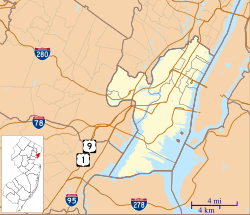Lenape
At the time of European settlement in the 17th century, Communipaw was the site of the summer encampment and council fire of the Hackensack Indians, [15] a phratry of the Lenape. They, along with the Raritan, Tappan, Wecquaesgeek, Canarsee and other groups who circulated in the region were collectively known as the River Indians by the immigrating population.
It is likely that the name is based in the Algonquian language Lenape. Earlier spellings are numerous and have included Gamoenapa, [15] Gemonepan, [16] Gemoenepaen, [16] Gamenepaw, Comounepaw, Comounepan [17] Communipau, [18] Goneuipan [19] There are a variety of interpretations of the meaning, though most sources relate it to being from gamunk, "on the other side of the river", and pe-auke, "water-land", meaning "big landing-place from the other side of the river". [20] (Current: "gamuck" meaning "other side of the water" or "otherside of the river" [21] or "landing place at the side of a river" [22] ).
New Netherland
Henry Hudson, commissioned by the Dutch East India Company, anchored along the shore at Communipaw in 1609 during his explorations of the Upper New York Bay, North River (Hudson River) and Hudson Valley. [23] On September 12 he sailed up to Communipaw, where Robert Juet, his mate, wrote in the log that it was "...a very good land to fall in with, and a pleasant land to see." [24] In 1634 one of the first "bouweries", or homesteads, in the colony of New Netherland was built at Communipaw as part of Pavonia, a patroonship of Amsterdam businessman Michiel Pauw. (Some have suggested that the name comes from Community of Pauw, which likely is more a coincidence than a fact. [25] [26] [27] [28] ) For a time it bore the name of the Dutchman who settled there, Jan Everts Bout, [29] and was called Jan de Lacher's Hoeck, [30] or "Jan the Laugher's Point", apparently in reference to his boisterous character. Plantations, worked by enslaved Africans, spread across the low-lying areas between the shoreline and the hill. [31] It was here that Tappan and Wecquaesgeek fleeing dominant tribes from the north had taken refuge in 1643. They were attacked in the incident known as the Pavonia Massacre, subsequently leading to Kieft's War. [32]
Originally the village of Communipaw was part of the colony under the jurisdiction of the Dutch West India Company. In 1653 it became part of the Commonality of New Amsterdam, [33] which included all the settlements at Pavonia, Manhattan, Staten Island, and Long Island). It became a separate village in 1658, [34] [35] [36] under the jurisdiction of Bergen, established at contemporary Bergen Square. By 1669, regulated ferry service to New Amsterdam had been established. [37] [38] After the last English takeover of New Netherland in 1674 it became part of the Province of New Jersey, in the county of Bergen, though it retained its Dutch character for hundreds of years. Washington Irving visited it often (at least once with future US president Martin van Buren) for inspiration. Writing in the early 19th century, he often referred to Communipaw as being the stronghold of traditional Dutch culture.; [39] he refers to it in The Legend of Sleepy Hollow . James Fenimore Cooper's The Water-Witch and Herman Melville's The Confidence-Man both mention Communipaw as stronghold in a similar vein. John Quidor, an American Romantic painter, created works inspired the village: Embarkation from Communipaw and The Voyage from Communipaw to Hell Gate. Suydam Street, which can be translated as "south dam", runs for one block south of Communipaw Avenue is taken early Dutch family, whose descendant, Rev. J. Howard Suydam, D.D, was member and historian of the Holland Society of New York. [40]




